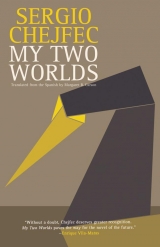
Текст книги "My Two Worlds"
Автор книги: Sergio Chejfec
Жанр:
Современная проза
сообщить о нарушении
Текущая страница: 5 (всего у книги 7 страниц)
The effect of that layout was a deceptive appeal, because at first you believed you were in a park, while in fact you were in several at once, though in none of them, however, did you see that flashiness associated with the most widespread and predictable ideas of natural beauty. It was a park on the edge of extinction and oblivion, that was obvious, but it lived on thanks to its invincible beauty and to the wisdom that had designed it to endure in times of destruction. The breeze shifted every now and then, bringing minuscule drops from the fountain my way, which nonetheless didn’t soak me, but rather refreshed me like dew. In a bit I would be getting up and resuming my walk; I had known that before I’d made my decision. The powerful jets of water competed with one another to go the highest, and some of them, those which because of a defect or a deflection at their base veered sideways, traced a parabola that was hard to make out when the jets crossed each other, or when they reached their highest point, known as the apex I believe, and began to descend.
Through the spray of water I saw the bougainvillea on the other side of the esplanade. I’m not exaggerating when I mention the curious refraction of its brilliantly colored petals, deep red, as I said before, which as they became smudged like a still life in an Impressionist landscape, faded, were less strident, more opaque, and strangely, thanks to the watery effect, these same petals became more tangible, as if their natural adornment had overwhelmed them and the water particles and mist sought to correct this excess. I sat like that for a while, in wonder at the workings of the fountain. Its circular basin was, logically, full of water, near overflowing. It was odd to see how a boiling effect was created – I know no better way of describing it – a consequence of the thousands of drops of water striking the surface. For a moment it seemed to me that the jets of water, launched up from the widest variety of places and at random, and yet with the purpose of creating an illusion of freshness and turbulence, shot into the air not as jets, I mean, not as water forcefully expelled and sent in a predicted direction, but instead as traces of dotted lines marking out a journey. The water wasn’t flowing, in reality someone had drawn it, just like the fountain – a stone grey made with soft graphite – and the esplanade, too, had been drawn somewhat lighter than its physical version, as the trees had been with their various intensities, the patches of shade beneath or between them, and also the people, alone or in groups, who’d been sketched as well in the most schematic or typical poses to adopt in a park. Even the water drops, whether the ones that exploded in splatters on the surface, or the lightest, most volatile, nearly vaporized one, were all, thanks to its display of minutiae, represented in the drawing.
Anyhow, nothing in that picture caught my attention more than the flow of the water, because it was the only object that appeared as a sign. And that inconsistency, or abstraction, compared to the veracity of the other components – which were in keeping with their natural proportions and with the verifiable nuances of light – made the representation of the jets more authentic, because in this way they proved double, or bifronted. It was a symbol, that is, the flow of water had an added materiality at the same time it lacked one. Was it water or was it a different element? Because in all likelihood an old route was being shown, or simply a prediction: the place through which the water jets ought to pass.
As might be readily expected, after having this thought I began to imagine a world made up of dotted lines, the indecisive sketch of its contours, the design of its relationships. Just as with the water, one could trace sounds, physical trajectories, material changes and the passage of time. The line denoted the relationship between objects, which could be of the same nature or not. But naturally, since this was a physical representation, each connection lingered on, permanently drawn on the paper, superimposed on earlier or later ones, creating the “fountain” effect I mentioned before: a weft of dotted lines that crisscrossed, and whose arcs ended up a bit tangled, delineating a complex skein; not illegible, with some effort, just slightly chaotic. And in that denseness I found a kind of dramatic consistency, as much in the most immediate, theatrical sense, as in the tragic sense: the fatuous display of the real as the triumph of destiny.
I don’t know what came over me. This interpretive behavior or feeling so conquered me that when I saw a distant hiker pouring his maté, I immediately reconfigured the stream of water, which was of course invisible to me in the distance, as a dotted line that dropped from the lip of the thermos making a curve. The line I restored had an extra feature: it bulged a bit exaggeratedly, was rounder and more pot-bellied than in reality, the better to stand out. The addition of the curve, the paunch, stood for the price of becoming visible and, in the process, acquiring consistency. That’s why I’m not exaggerating when I say that for me that afternoon in the south of Brazil the world was transformed. From one single and simultaneously inconsistent place, the universe reorganized itself at will, according to relationships that were always visible. In the middle of the day, what was visible was radically unsettled, or better still, it appeared in a form until that moment wholly unknown, at least not by me. .
I decided to leave the bench and resume my walk. I looked over to where the old man was sleeping: he hadn’t moved, other than swatting the occasional insect. I looked at his hands, folded together over his belly, and only then did I realize that the book I’d taken out when I sat down was still in my lap; at one point I’d opened it, surely like those readers on trains or in waiting rooms who interrupt their reading, look up, sit there rapt in something, and don’t start reading again for quite some time. I had fallen into one of those reveries, I realized now, and I also knew I wouldn’t return to the book for the rest of the day, or even attempt to.
The alameda that served as a stage for the monumental fountain opened out impressively; it must have been a hundred-odd meters long and some thirty meters wide. It offered two parallel walkways, which ran its entire length, crossed every few meters by transverse paths. Between the walkways was a narrow watercourse, half-concealed by the paths, beneath which you could make out small cascades or locks through which the water travelled on its way from the fountain. Trees surrounded the area with an equal denseness. Given the land’s gentle downward slope, from its topmost point the alameda seemed more extensive than it really was; but above all it looked like a startlingly geometric clearing amid the dense plant life, because wherever one looked one could make out, under the green of the trees, shadowy masses, spaces at first sight overgrown and impenetrable. I headed off down one of the walkways. On my right I could distinguish something like an Oriental garden, or strictly speaking Japanese, with a great number of stones and promontories, shallow waterfalls, and very narrow canals that connected two ponds that were equally diminutive, given the scale of their surroundings. From a distance I saw too, a number of sculptures, of a Buddhist sort, solid and dark gray, which because of the contrast these made with the innocent wooden bridges scattered here and there gave the garden a mien that was somber, even threatening, rather than harmonious.
Toward the left of the alameda, in the other area, stood a dense forest, broken at times by a few small clearings where they’d set out rustic tables for snacking or picnicking, or both things at once. I spied three men sitting around one of these tables, devoting themselves to what appeared to be a game, dominoes or cards, I couldn’t tell. Needless to say, I had reason to doubt my first impressions; the dominoes may have been a misperception, a mere whimsical transposition of images from the past, of those facts, perennial in their way, that alight in one’s memory and lead a furtive life there, surface occasionally and are then obliterated until their next appearance. I recalled a fairly hot summer, in another city. The doors and windows in the neighborhood open day and night, the neighbors avoiding the insides of their houses, etc. I remembered the dry slap of the dominoes on the tables set up in the street or in courtyards and gardens. Sessions that lasted for hours. Several games were most likely being played, one after the other, but as a result of the repetition and the unrelenting heat, these turned into a single game that never ended. As a background to the slapping of the tiles, you heard the murmur of voices; it was the conversation that flowed on, independent of the game, to be interrupted every now and then by long intervals of silence, or, depending on the ups and downs of the play, by a volley of shouts that died away almost instantly. And it wasn’t just one table, there were hundreds spread out all over the neighborhood, from which the sound of the slapping Bakelite would carry distinctly, although that didn’t matter, because given the similarity of the sounds, one could reconstruct those that were the faintest, determine their true source, and above all, their true color.
I went on considering the waves of sounds that ran like currents and seemed to work by emulation. I would hear them far off, then near, I’d feel how they enveloped me, little by little, then left me behind, their aftereffects slowly fading, and so it went, several times a day. I was capable of finding a poetry in that, but even to me, accustomed to being satisfied by so little, it seemed obvious. As is evident, I was growing gloomier and more fatalistic. Maybe that’s why I thought it all too likely that the park would offer me no other varied or interesting things, though it’s true that at that point in the afternoon – or more generally, in my life – I could no longer be sure of what I expected. I then decided to find the closest exit. I wanted to return along a different route and perhaps in this way come across some impressive monument, a grand gateway arch, the iconic portal, I don’t know, because everything told me that I’d approached this park haphazardly, and it had therefore revealed itself to me slightly at random, failing to display its potential pathways or its perhaps intentional contrasts. On the whole, the same thing always happens to me. I set out from the margins or at the back doors, and that obviously determines how my impressions unfold. A handy example is the aviary, a place whose melancholy had surprised me, and which I had no desire to visit again; its melancholy would probably have moved me if I’d come across it in another sequence. I no longer remember the aviary in that way, but I was still under the effects of the place, the silence typical of caged creatures. And so, desiring to escape my own associations, I left the Buddhist area behind and took one of the side paths to the right, which led into the heart of the park, crossing it diagonally.
Once again I discovered on the ground the kind of earth with which I was by now familiar: a worn, near-pulverized gravel that resembled dirty, powdery sand. As I walked along, the noises from outside became more subdued and, apart from the predictable trillings and screeches now and then, a threatening silence prevailed. I don’t know, to me the silence seemed the most visible proof of the falsity, or rather, the invention or manufacture, of an allegedly natural environment in the middle of a city. In the past, the park had probably been the site of farms or a post station, and then the city proceeded to engulf it. As I considered this, I realized that my dichotomous thinking was surfacing, because on the one hand, I love parks – or their funereal variant, cemeteries – and love them far more than any space devoted to natural habitat, or the alleged wild; but on the other, I never pass up a chance to slander them inwardly and verify, time and again, whenever I walk through them, the forced affectation that sustains them. At any rate, I suspect it’s a useless battle, lost in advance: who would have any interest in what I think about parks, or better still, who would care what I think about anything. That’s why, as I wrote before, I prefer untended parks, those that have been overtaken by neglect, because no one expresses any strong opinion about them and so they take on a still more autonomous life and, in that sense, presumably a more authentic one. . Although of course, one can never know.
I now covered a long stretch on the diagonal path, where everything seemed to sleep, protected by the shade. It was an ideal path for walking aimlessly, indifferently. I kept seeing discarded candy wrappers and empty soft-drink cans on the ground. Some had been there for a long time, since they were weatherworn and had, in their own way, adapted to the colors in their surroundings. Because there were no benches or tables nearby, I surmised that on the weekends the path was heavily used. This made me want to know where it led to. From time to time I saw large trash cans, which were in any case brimming with papers and plastic bags. Not much else at all, besides the trees, the dry earth and the predominant shade. As had happened several times earlier on this outing, before long I spotted a light area toward the end of the path; and when I drew closer, some ten minutes later, I glimpsed a tableau that at first disturbed me, I don’t know why: over there a good-sized, tranquil lake lay hidden, and from where I was approaching I could make out some unexpected, gigantic swans, stock-still and arrayed as if in regimental formation. As I drew nearer to the water and the scene grew better lit, I felt a mixture of wariness and wonder. Wariness owing to something quite primal, for which I realized I wasn’t prepared: simply the size of those pedal boats in the shape of swans, which one associated more with some monstrous scale than with any idea of a replica or an amusement; and wonder because of the illusion of standing before an inanimate army, but one that seemed subject to a latent vitality, ready to awaken or be activated at any moment.
Once at the edge of the lake, amid thickets of greenery slanting out toward the water, which made for a certain difficulty in moving about, I could appreciate the grouping of swans in all its majesty and realism. They were some three meters tall, and despite their size, their bodies were perfectly proportioned, so that the stylized curve of their necks, famously praised by modernistapoets, offered in these gigantic models a new and incontrovertible argument confirming it. The swans’ verisimilitude extended even to minor details, such as the color of their bills, a brilliant orange verging on red, with one exception alone, whose bill was yellow, as in all likelihood occurs now and then in real life.
I don’t know whether there are many species of swans; the one I’m familiar with was well represented there in any case: the so-called common swan, its body white and with its characteristic black mask rendering its face mysterious and each specimen seemingly identical to the rest. Nor do I know the name for the other group I saw there – most likely “white-faced swan,” as simple as that – or perhaps these bordered dangerously on geese, since their only difference with the others was that they lacked a mask. Otherwise both types displayed a similar morphology. As the name indicates, the face of the white-faced swan exhibits no other color, apart from its bill, already mentioned, and its black eyes. The common swan, on the contrary, has a black cloth that rises from the base of its bill and stretches to cover its eyes. Described that way, it might seem to be a blindfold, but actually the mask is a bit wavy, and lends this variety a grace and dynamism that would otherwise be lacking without this whimsy, which at first strikes one as theatrical; also, toward the edges of its face, where one would expect its ears to be, if it had ears, were white openings that, I think, serve as eyes. Anonymous swans, we might imagine, attempting to pass incognito. The white-faced ones, on the other hand, have eyes that are two large black circles practically stamped on the skull.
Unlike almost all real swans, these were missing the caruncle, the fleshy outgrowth that grows at the base of their bill or on the head, and which, according to the field guides, tends to be erectile. It made sense that the swans lacked this accessory, since the only motion they could possibly simulate was by virtue of their pedals. I keep a photo in which they are arrayed in rows of six beside the boarding ramp, presumably moored. Beyond what I’ve just described, both their silence and their demeanor impressed me. These qualities might seem fantastical, but I knew I wasn’t deceiving myself: one has to activate one’s imagination to bestow life on these swans. It’s the same with all inanimate things, we have to imbue them with life, but rarely do we find in the inanimate the type of silence or demeanor I now confirmed, nor to such a degree, as we seek, let’s say, to fit them into some human scale. On Mondays the swans clearly didn’t swim too much. If one wanted to endow them with life, one could believe it was owing to the fatigue that had built up over the weekend, their heaviest workdays. Nonetheless, despite their being, so to speak, parked that way, their lifelike side was borne out in the fact that they seemed ready to move at any minute.
The swans held two passengers and had dual sets of pedals, and on the left, similar to a car, was an semi-circular iron handlebar that made do as the rudder. I began to walk through the area, gazing at the lake through various arrangements of branches, or straight through the leaves of shrubbery. I stood in the shade, camouflaged in my own way by thickets that were nearly marshy, but curiously, everything else, the whole of the lake and the group of swans, but not me, seemed to be crouching, lying in wait for a certain signal. The trees on the opposite shore of the lake were mirrored in the water, itself fairly green, but some patches of bougainvillea, lilac-colored in this case, also stained the lake’s surface.
Probably because of their uniform alignment, but also the absence of any distinguishing marks – the exception being the yellow-billed swan – the swans at first seemed to lack individuality. But that first impression didn’t last long, because when I’d walked onward, after taking a path that ran parallel to the shore, and reached the swan-rental facility, from which I could consider the creatures from their tail ends, I could see that a particular number had been painted on each. Closest to me were Nos. 24, 3, 15, and 11; Nos. 18 and 10 completed the row. I’m not sure why these details matter. In a park where the presence of humans had adapted itself so closely to the nature of the surroundings, these artificial models seemed mysteriously alive to me, in their own fashion eloquent and mute at once.
In order to go out on the dock and board a swan, you had to pay a rental fee at a narrow cement ticket booth with a Spanish-tile roof, a little like a chalet-style guardhouse. A sign atop it said PEDALINHOS and listed the prices for weekdays, weekends or holidays. The minimal rental was fifteen minutes, which may give the wrong idea about the true dimensions of the lake, since whoever wanted to go to the far end would need a good deal more time. It seemed unlikely to me that the swans were capable of getting up much speed, and a little later, when I saw one in action, I confirmed their slowness. The planking that doubled as a dock had pipe handrails painted green. To the left of it, more difficult to access by water – on foot you’d have to cross a narrow and perhaps risky plank – were moored other, more conventional boats, resembling open cars, which were clearly old, less graceful, and out of use for some time.
The lake is in the form of an elongated ellipse, and the pedalinhostation stands just past the midpoint of one of its longer arcs. I could have easily circled the lake, following the path that paralleled the shore just a few meters from the water, but for some reason that I cannot now recall, maybe because I simply thought it was getting too late, who knows why, in the end I didn’t. For almost its entirety the lake is surrounded by a strip of marshy land, low brush, and wild thickets. The pedalinhoarea stands next to an open plaza separated from the lake by still more plant life, through which one sees only intermittent reflections from the water, as if the lake were a mere intuition or belonged to a strange land.
The plaza next to the swans has as its epicenter a singularly beautiful Rationalist terrace, where there rises a structure that resembles a spinning top, with concentric circular platforms of uneven size, its Constructivist style similar to that of the small guardhouses described earlier, and painted the same antique yellow. I remember that the name of the architect, whose surname was German, appeared on one of the side walls of the circular structure. I walked around the small plaza, from which one could see the pedalinhosgleaming in the sun, especially their curves, that is, their flanks and their necks. I couldn’t imagine the spot crowded with families or young people on a Saturday or Sunday, since it now seemed definitively overcome by solitude. At the entrance I’d seen the swan attendant, dressed in a shirt that was blue or sky-blue, and an ice cream vendor in a yellow-trimmed red uniform, who had left his cart standing in the middle of the path a few meters away. Both stood leaning against one of the short columns that guarded access to the plaza. Every so often the boat attendant would turn to check on the swans; a reflex action, no doubt, since he could be sure no one was around. Or perhaps he, too, also intuited the presence of a flickering or secret life in them and, prompted by this suspicion, kept a close watch.
At times a solitary walker, like myself, appeared on the path, or one with children, or perhaps a couple, whatever; but whichever it was, whether a regular or a first-time visitor, everyone walked around this section of the park as if gone astray, or on the whole with the slow step of someone groping his or her way through unsafe or unfamiliar terrain. Conceivably it was the deep shade, contrasting with the luminous reflections from the lake, that gave the area a cave-like air, the air of a place given over to secrets and surprises. .
The attendant and the ice cream vendor kept at it, bonded, so to speak, by the advancing afternoon. They amused each other with an occasional exchange of brief, languid remarks, subsiding afterward into a long silence until their banter resumed. I was able to observe them very well when I sat down on the steps of the terrace to enjoy the tranquility of the place. They were wholly oblivious of me, it’s even possible they never saw me, because I remember that as I passed by them I believed myself to be invisible, to the point of feeling a bit uncomfortable, since in such silence and solitude one doesn’t expect to be ignored as if one didn’t exist. In fact, I assumed, as is my habit, that under those circumstances a greeting was essential, and I half-sketched a wave as I walked through the entrance quite close to both of them, or I believe I did. But it was as if the wind had passed by. I won’t deny I felt slightly mortified, if only fleetingly, since I’d forgotten all about it a moment later.
I’d like to know just when my need to greet others originated; there must have been a first time, because it wasn’t always like this: I used to greet people just enough, in accordance with established conventions. Now for the most part I believe I still do a good job at it, though at times an imbalance arises. I venture a greeting, or am about to do so, then realize it’s not reciprocated. The urge is irrepressible, and inconvenient too, because there’s nothing more distracting than greeting someone, yet it’s stronger than I am. I don’t know what happens to other people, but in my case I think I know the cause: an uncontrollable mimetic urge impels me to greet. It’s not that I want to be taken for a native, which would be impossible anywhere, but that I simply seek to be regarded as normal. I have an extremely basic idea of normality, related solely to what’s superficial. But since for foreigners, what’s superficial is always what’s most visible, a greeting is the price you pay for wanting to be normal.
The ice cream vendor and the attendant weren’t obliged to be normal, while I’m obliged to act it. I’m required to act normal, I repeat, in any place, including my own country. That’s why what I described earlier happened, as I was diligently scrutinizing my map in the middle of the sidewalk, and all my doubts and worries briefly disappeared when I believed the street vendor was waving to me from the gutter, alongside the passing traffic. I returned his greeting and began walking toward him. And as I said, I felt tremendously embarrassed when I realized he was hailing another person to ask for help. Partly because of it, I turned my eyes back to the map, as if I were hiding, and kept on trying to make sense of it. I now replayed those events and was under the impression I’d undergone them a good while ago, not merely a few hours earlier; and furthermore, I was under the impression I’d experienced them in another situation, in another time scheme, and under other conditions. I don’t know whether this may have been an effect of the park – most likely it was. Parks and long walks separate me from time and install me in a different dimension, an alternate one, obviously compatible with the true one, shall we say, or in any case with the regular one, isolated and at times autonomous as it may be.
For instance, from a certain distance I took part in the predictable development of that muted conversation between the two men, the swan attendant and the ice cream vendor, and despite there being nothing in their dialogue that in the least concerned me or aroused my curiosity, I recognized in the scene an essential act, a privileged and moving event which I was flattered, even proud, to have witnessed. It might sound a bit presumptuous, but that’s how it was. Somewhat like my reaction to the landscape the ground often presents. It was a simple or forgettable conversation, a way of killing time; perhaps it wasn’t a conversation at all, but for me it had a transcendent quality. I thought: the park, the harmonized light and shade, the lake, the manufactured nature, the world in miniature, the imitation of fauna, etc., and on top of that, the communication, whose possible simulation I had no reason to rule out, between two individuals. Never before had a dialogue seemed so essential to me. I don’t mean that in dramatic terms, as something essential to resolving a conflict or a mystery, but rather in terms of its human significance, I don’t know what to call it, metaphysical might perhaps be too much. .
Anything, it seemed, could distract those two men, except myself, of course, and when I passed them again on leaving it was as if nothing had happened. My next destination was a building that rose in the distance, at one end of the lake, spacious and low-built, beneath the green canopies of the trees which framed it from behind. The lake was to my left, sheltered by the profuse greenery which seemed to seek to disguise or to conceal it. At one point I thought that in all likelihood that afternoon would be my only time in this place, and so I couldn’t resign myself to the idea of not having another look at its waters. So I first went deep into the grass and then slipped through the stunted shrubs and trees by the shore. The water wasn’t very clear, but a few carp were visible, and one or another turtle swimming with effort, slowly, apparently at risk of sinking, nothing but their diminutive head, like a small nut, bobbing on the surface.
In controlled lakes such as that one, you can analyze, or at least see, the vicissitudes of a well-regulated life. Turtles and fish swim in peace, it’s hard to imagine anything threatening them. A life well-regulated so as to go on, oblivious of the struggle and adapted to its own, possibly unhappy, subsistence. These creatures, including the swans, could give me some kind of a lesson. I tried to see it clearly, but something hindered me; probably weariness. After a life devoted to thinking trivialities, weariness was my body’s last protest, the cry for help, now nearly extinguished, which still contains some kind of hope. I don’t want to be overly abstract, but at times weariness translates into longing. That’s what I felt at that moment: a longing for the well-regulated life, and for what’s foreseeable.
Most likely owing to my shadow as seen from underwater, and the hope for food it represented, a few fish swam up to me, followed by two or three turtles. I had nothing more to offer them than my bitter thoughts and a vague feeling of solidarity with their condition, a condition in which I recognized myself completely: if their lot had fallen to me, I would have been the most well-regulated of carp and the most predictable of turtles; I had nothing to offer them and yet they stayed there, without moving, drawing a semi-circle before me, hanging on my movements as if they made up an audience willing to watch me, with their own rules for positioning themselves and their own patience. Of course, I felt immediately called upon to do something. A writer always dreams of a real audience, and this was the most I could aspire to. Needless to say, I was tempted to give a speech or at least offer some brief disquisition. Because the realest audience is the one that understands the least, I mean, when it flaunts its deafness, or at least a bit of resistance, when it indicates our uselessness, etc.








